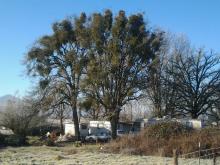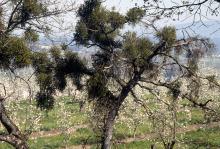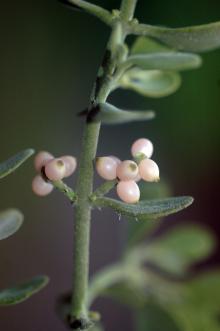Cause Phoradendron villosum, a parasitic plant that affects white oak (Quercus garryana), black oak (Q. kelloggii), red oak (Q. rubra), scarlet oak (Q. coccinea), and pin oak (Q. palustris) and occasionally is on alder, aspen, birch, locust, manzanita, buckeye, sycamore, walnut and willow. Generally found in western Oregon. This mistletoe does not grow on conifers or on other hardwoods. It derives water, mineral nutrients, and some organic nutrients from the xylem of the host. Mistletoes are capable of absorbing so much water and mineral nutrients from the host tree that distal portions of branches that extend past infection sites ultimately die from water and nutrient stress. Most of its organic nutrients come from its own photosynthesis.
Birds such as robins and bluejays eat and spread seeds to other trees. Seeds pass through the bird's digestive tract but retain a sticky covering of threads. Once deposited on a branch, the seed germinates and infects small branches of a suitable host. The plant that develops produces many seeds that continue to infect the same host. Mistletoe may increase dramatically within a single tree where birds feed on berries, roost, and congregate. More and different kinds of birds have been shown to be associated with high mistletoe load in Oregon white oaks. The fruit is an important food for the Western Bluebird (Sialia mexicana) and other wildlife in late autumn and early winter. Seeds, however, may be toxic to humans if eaten.
Considerable folklore and legend surround the properties and use of mistletoes including spiritual powers, medicinal uses, fertility, and good fortune. Many of these are associated with other genera of mistletoe. The origin of the custom of kissing under mistletoe is not known but may be associated with aspects of good fortune and fertility. There are no known replicated trials investigating these properties.
Symptoms The mistletoe is a large, green plant with somewhat hairy leaves. Stems are green and dichotomously (forked) branched. Plants usually are widely scattered on a branch. Flowers are inconspicuous and fruit are shiny, whitish berries.
Heavily infected trees are weak and grow more slowly. Weakened trees may be predisposed to insect attack and may succumb during drought or other adverse conditions. Branch and trunk swellings are frequent. Branches heavily laden with mistletoe often break off in storms or high winds; property damage may result. Principal damage to the tree is the mistletoe's unsightliness and, if branches die, a misshapen tree crown.
Cultural control
- Cut out affected host branches. New sprouts will grow if only the aerial shoots are removed.
- Removal of extensive mistletoe infection has been suggested to help trees cope with drought issues in southern Oregon. Only the mistletoe is removed and may need to be repeated several years later. There are no replicated research trials supporting this tactic.
Reference Mallams, K.M., and Mathiasen, R. L. 2010. Mistletoes on Hardwoods in the United States. USDA Forest Service Forest Insect and Disease Leaflet 147. 12 pp.
Pritchard, K.R., Hagar, J.C. and Shaw, D.C. 2017. Oak mistletoe (Phoradendron villosum) is linked to microhabitat availability and avian diversity in Oregon white oak (Quercus garryana) woodlands. Botany. 95:283-294.




